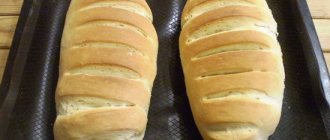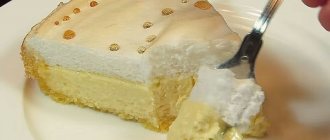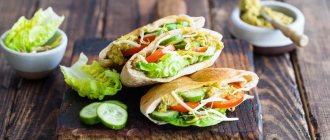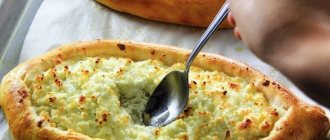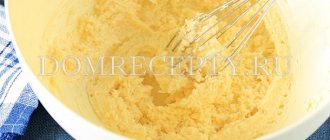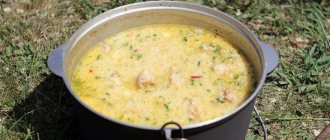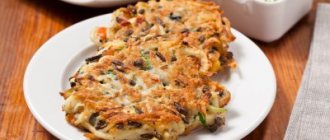Modern bakery products leave much to be desired: the lion's share of it is stuffed with leavening agents and artificial flavor enhancers to such an extent that the familiar loaves, long loaves and loaves, familiar to everyone from childhood, have long lost their taste appeal. The article suggests taking a trip back in time and preparing a simple sliced loaf in the oven. Recipes with photos will help inexperienced young housewives in cooking with their detailed instructions, giving pleasure not only from the result obtained, but also from the process itself.
Main characteristics of the product
Those who remember the “Soviet” version of the white loaf, with which they often drank tea, spreading it with butter or jam, note the fine porosity of the crumb, in contrast to the modern, spongy crumb, with large voids caused by large gas bubbles. If you follow the classic recipe for a sliced loaf according to GOST, then the finished product should have:
- thin crust of ruddy color;
- glossy surface;
- a shape resembling an elongated oval;
- small cuts on the top crust of the product.
Below are two recipes for sliced loaves in the oven: sponged (classic) and straight (quick). Both of them are considered correct based on state standards, so we boldly take on the preparation, having previously purchased quality products.
Appearance
The correct loaf has an oblong oval shape and even cuts. The product must be of the correct, non-blurred shape with a smooth surface without tears or cracks. The color varies from light golden to light brown. It depends on the recipe. If the bread contains more baked goods (fat and sugar), the crust will be browner. If there is no baking, then a lighter one.
To make it clearer: there are basic raw materials (simple recipe) - flour, water, salt, yeast. And there is an additional one - when various other ingredients are added (for example, sugar, butter). By the way, sugar should be within 4%, butter or margarine - within 3%.
The color can also be affected by baking time. If the loaf was not kept until ready, or was baked at the wrong temperature, then you will not see a golden crust! However, in enterprises the bread preparation modes are usually worked out, so this should not happen.
A high-quality sliced loaf should regain its shape when pressed. This ability mainly depends on the properties of the gluten of the flour from which the loaf was made.
Necessary products for the recipe according to GOST
The classic sliced loaf has a fairly simple composition, but the correct ratio of ingredients and skillful preparation of the dough creates a rather tasty bakery product. In order to prepare three loaves weighing four hundred grams, you will need:
- 450-500 ml of water. The amount of liquid depends on the quality of the flour.
- 750 grams of flour. Only premium flour is used if you want to get a sliced loaf according to GOST standards.
- The recipe from 1940 indicates compressed yeast - 15 grams, but if it is not possible to purchase it, then you can replace it with dry (fast-acting) yeast in the amount of 6-8 grams.
- 12 grams of salt.
- Two tbsp. spoons (without a slide) of sugar.
- 27-30 grams of quality margarine.
Preparing the dough
One of the main secrets of this product is preparing the dough according to the recipe on the dough. The sliced loaf is obtained with a light crumb, but without excessive fluffiness, as is the case with modern bread with baking powder and additives. The first step is to heat 350 grams of water to a temperature of 50 degrees, dissolve the yeast in it, rubbing well with a spoon, and add 375 grams of flour, mixing the mass thoroughly so that there are no lumps.
Next, cover the dish with the dough with polyethylene (there should be at least 3/4 of the empty space in it) and leave it warm: ideally 30-32 degrees. The average time for yeast activation to ripe the dough is three hours (sometimes a little more if the room temperature is below normal). If it has increased in volume at least four times, it’s time to start kneading.
Second phase: knead the dough
Heat the remaining water well and dissolve sugar and salt in it. Next, following the recipe for a sliced loaf according to GOST, combine this mixture with the dough, add sifted flour (all that is left) and knead a soft dough. During the process, add slightly melted margarine, which will give the dough the necessary plasticity, it will completely stop sticking to your hands and the table. It is important to thoroughly knead the lump of yeast dough, which becomes better and better with prolonged attention. Next, take a little refined vegetable oil, lubricate the walls of the bowl in which further fermentation of the dough will take place, form a lump and, placing it in a bowl, lightly swirl it in it so that the dough is coated on all sides with a thin film of oil - this little trick will not allow the dough to dry out if the container is accidentally opened.
Cover the top with a towel or clean cloth, return the bowl to a warm place and wait another hour or an hour and a half (this also depends on the temperature of the room). Important: 30-40 minutes after the start of the second stage of fermentation, knead the dough with your hands.
Bakery
Immediately before baking, make four to five cuts on each piece of dough with a sharp knife, holding it at an angle of 45-60 degrees relative to the product. The recipe for a sliced loaf according to GOST specifies four diagonal cuts, but you can experiment and make two or three horizontal ones, or eight small transverse ones, which will visually divide the loaf into portioned pieces. The oven must be well preheated in advance at a temperature of 230 degrees.
Sprinkle each loaf generously with cold water, place the pan in the oven and immediately reduce the temperature to two hundred. After 12 minutes, you need to open the door, turn the baking sheet with the front side to the back wall of the oven, brush the loaves with beaten egg or milk for gloss and continue baking for the same amount of time. Cool finished products on a wire rack.
Homemade loaf in the oven - 6 cool recipes with photos
Modern bakery products leave much to be desired: the lion's share of it is stuffed with leavening agents and artificial flavor enhancers to such an extent that the familiar loaves, long loaves and loaves, familiar to everyone from childhood, have long lost their taste appeal.
The article suggests taking a trip back in time and preparing a simple sliced loaf in the oven.
Recipes with photos will help inexperienced young housewives in cooking with their detailed instructions, giving pleasure not only from the result obtained, but also from the process itself.
Sliced loaf - step-by-step recipe for home cooking
Ingredients:
- Flour - 300 grams
- Chicken eggs - 2 pcs.
- Butter - 50 grams;
- Dry yeast - 1 teaspoon;
- Milk - 150 ml;
- Sugar - 1 teaspoon;
- Salt - 1 handful.
Preparation:
- Take a small saucepan, pour half of the available milk into it and heat it on the stove for literally 1 minute. Pour into a bowl for kneading the dough, add dry yeast, sugar, mix and leave for 10-20 minutes.
- When the foam has risen, add butter to the rest of the milk and leave for 5 minutes.
- Combine the mixture from two vessels, add salt, beat 1 chicken egg and knead into a homogeneous dough, adding a little flour at a time, for at least 10 minutes. The dough should be elastic, so depending on the type of flour, its amount can be reduced or increased. Let it sit for at least an hour.
- Break one chicken egg into a bowl and beat with a fork or whisk.
- Now the dough needs to be rolled out on a board into a circle, the thickness of which is about 0.5 cm. This circle needs to be tightly rolled into a kind of roll, and the edges should be pinched. Using a sharp knife, make slanted cuts and brush with egg.
- Cover a baking sheet with parchment, place our “roll” on it and leave for half an hour.
- Place the dough in an oven preheated to 180 degrees. Bake for 45 minutes until the loaf is golden brown.
Loaf with filling - a recipe for a delicious loaf with cheese filling
Ingredients:
- ½ loaf;
- 100 grams of butter;
- 100 grams of homemade cottage cheese;
- 3 garlic cloves;
- 1 bunch of green parsley;
- 1 bunch of green dill;
- a pinch of salt.
Preparation:
- Wash the green parsley and dill thoroughly under warm running water and place on a dry kitchen towel to dry. After this, use a sharp knife to finely chop the greens.
- Grind the cottage cheese with your hands, with a fork or grate it.
- Place the butter in a small unenamelled container and put it in the microwave for just a few seconds until it becomes soft.
- Carefully peel the garlic, rinse it with warm water to remove any residue, and pass it through a garlic press.
- On the loaf we make (not completely) cuts every 1.5-2 centimeters.
- Combine cheese, garlic, herbs and butter in one vessel, add salt and mix well. Fill the slits in the loaf with curd mixture and wrap in foil.
- Bake the loaf with curd filling for 15-20 minutes at 180 degrees.
Loaf with incredibly tasty filling with tomatoes and ham
Ingredients:
- 1 loaf;
- 100 grams of cottage cheese;
- 2 fresh tomatoes;
- 3 garlic cloves;
- 300 grams of ham;
- 100 grams of butter;
- parsley.
Preparation:
- Cut the loaf into two parts. On each we make deep cuts every 1.5-2 centimeters.
- Grind the cottage cheese with a fork, with your hands, or chop large lumps with a knife. You can also place the cheese in the freezer for 20 minutes and then grate it.
- Wash the tomatoes well in water, peel if there are rough skins, and cut into medium pieces.
- Peel the garlic, rinse with warm running water, squeeze out using a garlic press or grate on a fine grater.
- We clean the ham from the plastic wrap and cut it into small strips.
- Wash the green parsley from soil and dust, drain and finely chop.
- First remove the butter from the refrigerator 20 minutes beforehand so that it softens a little, or heat it in the microwave for a few seconds.
- In a small vessel, combine ham, tomatoes, garlic, herbs, butter and cheese. Mix and fill the slits in the loaf with filling.
- Wrap the loaf pieces in foil and bake for 15-20 minutes at medium temperature in the oven.
Loaf stuffed with minced meat
Ingredients:
- 1 loaf;
- 1 onion;
- 300 grams of minced meat;
- ½ glass of milk;
- 2 cloves of garlic;
- a pinch of salt;
- a pinch of black pepper.
Preparation:
- Cut the loaf crosswise into two halves and remove the soft part from each piece.
- Pour the removed loaf pulp with milk and leave for a few minutes.
- Peel the onion, rinse to remove any remaining peel and finely chop into small cubes.
- We also clean the garlic, rinse it under running water to remove any remaining soil, pass it through a garlic press or grate it on a fine grater.
- Strain out the soft part of the loaf, transfer it to a medium-sized bowl, add minced meat, onion, garlic, salt, pepper and mix well.
- Fill two parts of the loaf with filling, wrap tightly in foil and bake in a well-heated oven at 180 degrees for about an hour.
How to bake a loaf of garlic in the oven
Ingredients for the dough:
- Water – 0.5 tbsp.;
- Milk – 0.5 tbsp.;
- Salt - 1 tsp;
- Granulated sugar - 1 tbsp;
- Dry yeast - 1.5 tsp;
- Flour - 300 g;
- 1 chicken egg.
Filling ingredients:
- Butter - 80 g;
- Olive oil - 1 tsp;
- A pinch of black pepper;
- A bunch of green dill;
- 3 cloves of garlic.
Preparation:
- We wash the green dill well in water to remove dust and dirt, dry it and finely chop it with a sharp knife.
- We peel the garlic, rinse it, grate it on a fine grater or chop it using a garlic press.
- Melt the butter in the microwave, add herbs, garlic, pepper and olive oil.
- Pour milk and water into a large vessel, mix, pour out yeast, sugar, salt and, adding flour in small portions, knead a soft and elastic dough. Leave for 2 hours.
- Using a rolling pin, roll out the dough, then roll it into a roll.
- Turn on the oven at 200 degrees, cover a baking sheet with parchment and place the loaf on it. Bake for 50 minutes.
- Break one chicken egg into a small bowl and beat with a fork or whisk.
- When the loaf is almost ready, take it out of the oven and make a not very deep cross-section along its entire length. Place the filling there, brush the egg on top and bake for another 10 minutes.
Bacon sandwiches
This loaf dish is a quick hot appetizer, for which you need to take the following products:
- one loaf;
- one tomato;
- 150 g bacon;
- 100 g mayonnaise;
- 80 g cheese;
- a small bunch of greenery;
- salt.
How to cook:
- Cut the loaf into pieces about 1 cm thick.
- Lubricate each piece with mayonnaise.
- Cut the tomato into circles and sprinkle a little salt.
- Cut the bacon into slices.
- Place slices of tomato on pieces of loaf, top with a slice of bacon, and sprinkle with grated cheese on top.
- Place the sandwiches in the oven for 5 minutes. Temperature – 200 oC.
Decorate hot sandwiches with sprigs of herbs on top.
Source: https://profter.ru/vypechka/baton-nareznoj.html
Why are notches needed?
Presumably, the first sliced loaves appeared during the hungry war years, when exhausted people literally fought for a piece of bread. To make it easier to divide the bun equally, they began to make transverse cuts on them.
However, many consider this version to be erroneous and think that this is not why the notches appeared at all. In their opinion, cuts on the loaves simply speed up the baking time and prevent the product from losing its presentation. Allegedly, under the influence of carbon dioxide, the golden brown crust easily cracks.
But experienced bakers do not agree with this option either.
Professionals argue that the appearance of bread can only suffer if the technology is violated, and carbon dioxide easily seeps through microscopic pores in the dough, and it does not need cuts as such.
The number and direction of notches is simply a sign of a particular product and makes it easier to recognize. So, for example, a city roll has one longitudinal cut, and a sliced loaf has five transverse cuts.
Stuffed with minced meat
By combining meat filling ingredients with spices and herbs, you can diversify the taste of the dish. The meat component can be different: chicken, turkey, liver, minced meat (pork with beef, beef with lamb or just beef).
- Loaf – 1 pc.
- Homemade minced meat (pork and beef) – 300 g.
- Cheese – 100 g.
- Onion (turnip) – 1 pc.
- Tomatoes – 2 pcs.
- Pickled cucumbers – 2 pcs.
- Vegetable oil (for frying) – 2 tbsp. l.
- Milk (for soaking the bread crumb).
- Salt, herbs, spices - to taste.
A fragrant and tasty stuffed loaf can be prepared in just 1 hour.
- To prepare the loaf for stuffing, you should cut it lengthwise, dividing it into the main part (3/4 of the loaf) and a thin “lid”. The loaf must be freed from the soft part so as to obtain a “shape” with walls no thicker than 1-2 cm. Immediately pour milk over the crumb pieces.
- The onion is fried in vegetable oil until transparent, then the minced meat is added. It is necessary to fry with constant stirring so that the minced meat becomes almost ready and crumbly. Then you need to add the diced tomato and simmer with the minced meat for a few minutes.
- After removing from the stove, you need to season the mixture with salt and spices; add finely chopped cucumbers and herbs.
- Next, squeeze out the bread crumb soaked in milk a little and add it to the filling, thoroughly mixing everything until smooth. Fill the loaf, place it in a greased pan, sprinkle with 1/2 of the grated cheese and cover with a lid. Sprinkle the remaining cheese evenly over the top of the entire loaf.
- The loaf should be baked at 180 degrees for about 30 minutes.
Preparing the dough using the straight method
If we consider that the standard recipe for a sliced loaf according to GOST (in the oven) involves a sponge method of preparing dough, then many refuse it, because they know that this is a long process, and it does not always work out due to the inexperience of the cook. Naturally, bread made with sourdough will always taste better, but if time is limited, you can use a simple, non-dairy method. To do this, follow these step-by-step steps:
- Dissolve yeast, sugar and salt in heated water, add melted margarine and 1.5 cups of flour, stir thoroughly, removing any lumps if they form. It is very convenient to use the mixer at low speeds.
- After 4-5 minutes of the process, add the remaining flour and knead a pliable dough, lightly dusting the cutting table and hands.
- When the plasticity of the dough is satisfactory, roll it into a ball and place it in a deep bowl, covered with polyethylene. Place in a warm place (28-32 degrees).
- After half an hour, knead the dough with your hands, and do the same procedure again after 40-50 minutes. The entire fermentation process of the dough should take about two hours, during which time the dough should at least double in size.
Next, the process of forming and baking loaves is carried out according to the scheme described below: it is identical for all types of yeast dough.
Sliced loaf made from premium wheat flour according to GOST 27844 – 88
trablin
Hi! It’s been a bit of a busy week, and I think that’s a good thing.
I remembered yesterday that I didn’t finish the job I started, namely the publication of recipes for loaves in accordance with GOST 27844 - 88, a universal recipe card for which I gave last summer. I will finish this topic.
I’ve already talked about forming loaves a dozen times, so I allowed myself to be a little naughty, as can be seen from the photo. Sliced loaves from premium flour are prepared in two ways: using sponge and using the straight method.
With the straight method, all the raw materials according to the recipe are mixed at once, the fermentation time of the dough is 4-5 hours, with 1-2, or even three kneading of the dough during the fermentation process. This time we will consider the method of preparing dough on sponge, with the addition of instant yeast.
For two loaves weighing 400 g.
Premium wheat flour – 540 gr. Water – 310 gr. Sugar – 32 gr. Margarine – 19 gr. Salt – 8 gr. Instant yeast – 1.5 gr.
Opara:
270 gr. flour 210 gr. water all yeast Mix yeast with flour, pour into water and mix the dough. Knead for 2-3 minutes. Cover the bowl with cling film or cover with a plastic bag. Fermentation time of the dough is 3.5-4 hours. The finished dough will increase 4-5 times in volume and begin to collapse in the center when you tap on the bowl. Fermentation temperature of the dough is 28-30C. Ready dough:
Dough:
Flour – 270 gr. Water – 100 gr. Sugar – 32 gr. Salt – 8 gr. Margarine – 19 gr. Dough – all Melt the margarine and cool to room temperature. If you don’t trust margarine, you can replace it with a mixture of butter and vegetable oil in a ratio of 4 to 1. Dissolve sugar and salt in water, pour the water into the dough and stir thoroughly until smooth. Add flour and knead the dough.
The dough kneading time is 8-10 minutes, by hand in a large bowl (this is more convenient at the beginning of kneading), in a bread machine or using a dough kneader/mixer. Add the prepared margarine to the dough 5 minutes after the start of kneading. The finished dough will be smooth and will not stick to your hands.
Grease the bowl with a small amount of vegetable oil, roll the dough into a bun, place it in the bowl with the smooth side up, not forgetting to roll the dough around the bowl so that it is covered on all sides with a thin layer of oil, this will protect the dough from airing. Cover the bowl with film or a bag. Fermentation time for the dough is 60-90 minutes, at 28-30C.
The dough is given one knead, 30 minutes from the start of fermentation. Place the finished dough on the table, divide in half. Carefully fold each half into a rectangle, cover with film and let it pre-proof for 20 minutes.
Then form the blanks into blunt loaves, pinch the seam and place with the seam up in a thick cotton towel or burlap or canvas rubbed with flour. Sprinkle flour on top and cover with the same towel, or its edge, if the length allows. Proofing is complete, 45-60 minutes.
Half an hour before the end of proofing, you need to turn on the oven and warm it up along with a baking sheet or baking stone. T = 230 C. Carefully transfer the separated loaves onto a sheet of parchment, make 3-4-5 shallow diagonal cuts on each, spray well with water and place in the oven.
After placing the bread in the oven, immediately reduce the temperature to 200, and after 10 minutes, ventilate the oven chamber, reduce the temperature to 180 and finish baking the loaves for 15 minutes until golden brown. For gloss, grease the finished bread with brewed starch jelly (1 teaspoon of starch in a third of a glass of cold water. Stir, bring to a boil.) and keep in the turned off oven for 1-2 minutes. Cool on a wire rack.
Or form a bun out of the dough, place it on paper or a mat, cover with a bowl, let it rise, make a cut to avoid tearing the crust, and then do the same. Cutting the bun: And if you play around and make the cuts in a baguette style, the appearance will be much more interesting :Section of the loaf:The best use of such bread: trablin
Added a few more photos to the sliced loaf recipe: https://trablin.livejournal.com/341178.html
I also updated the catalogs - you are welcome.
Page 3
?
|
trablin
Somehow this topic has become too often mentioned; people ask me about sourdough several times a day. Writing the same thing to different people somehow gets boring. I see two options - ignore or open the topic once and for all. My sourdough has been alive and well for almost a year, it smells great of fruity apples and raises rye dough by 3-4 times, and wheat dough (after feeding it with another flour) by 4-5 times, which not every sourdough is capable of, actually. And yet, I am ready to describe in illustrations several recipes for developing sourdough, wheat and rye. Although it’s easier for me to post links here to famous bakers on the Web, of which I am not yet one. That’s why I want to ask you.
Is there a need for a separate article about sourdough in this magazine?
It is enough to publish links to other blogs where this issue is covered
12
(6.3%)
Source: https://trablin.livejournal.com/341178.html
